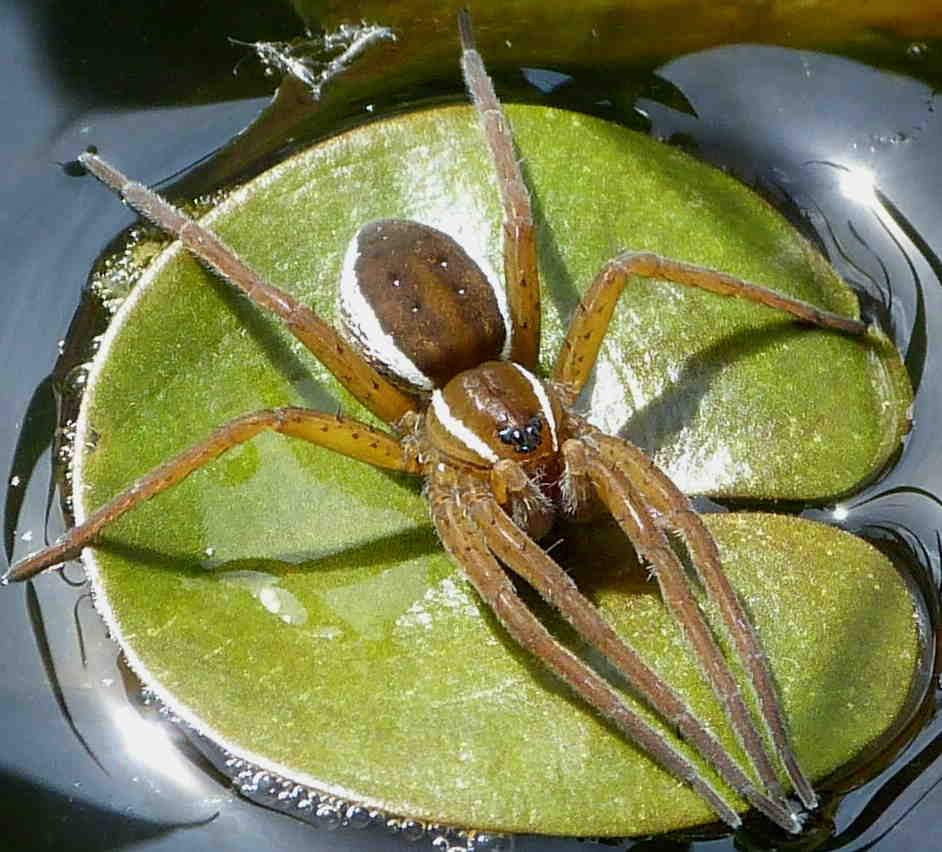Introduction
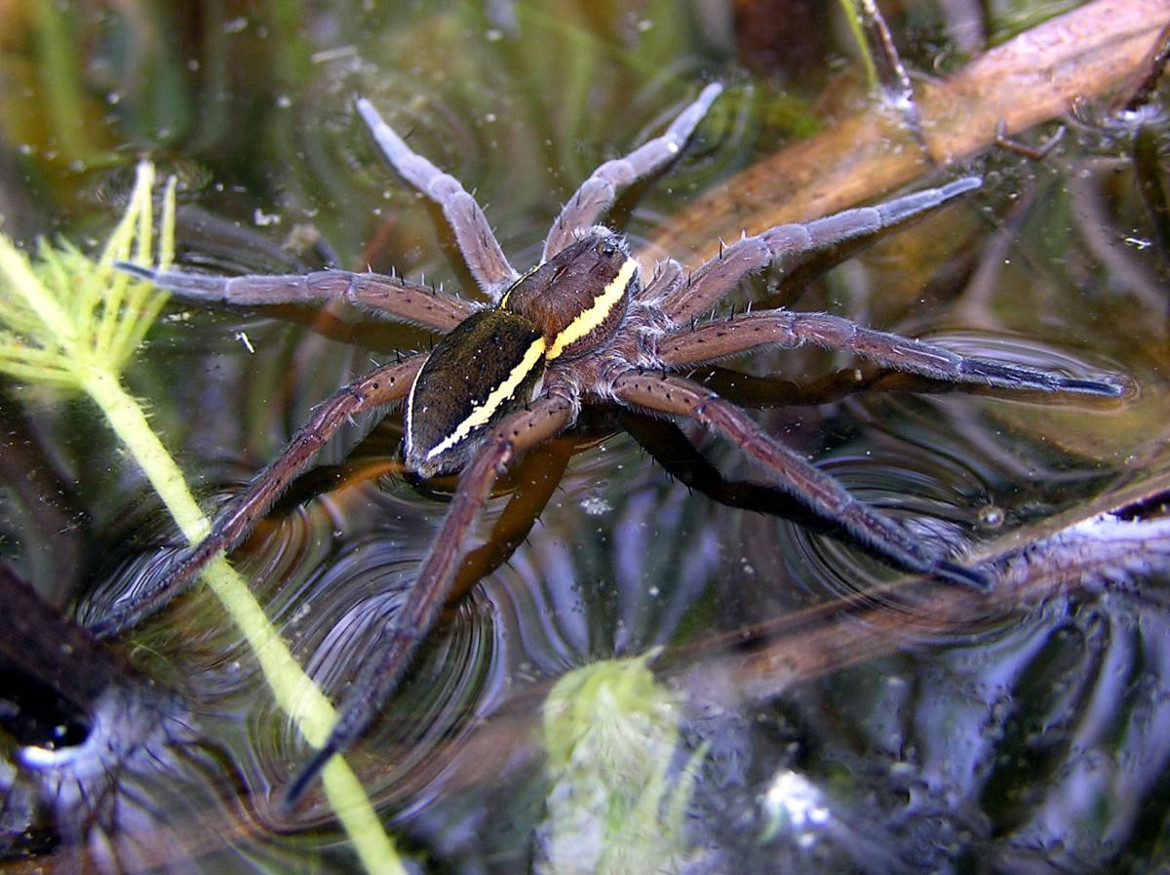
Dolomedes plantarius the Fen Raft Spider is one of two species of the genus Dolomedes (Family Pisauridae) that live in Europe. It is a large, semi-aquatic species, with adult females reaching body lengths of up to 23mm, and spanning up to around 7cm including their legs. Most individuals are strikingly marked, with black or brown bodies and white or cream stripes along the sides of the cephalothorax and abdomen (see Identification).
Habitat
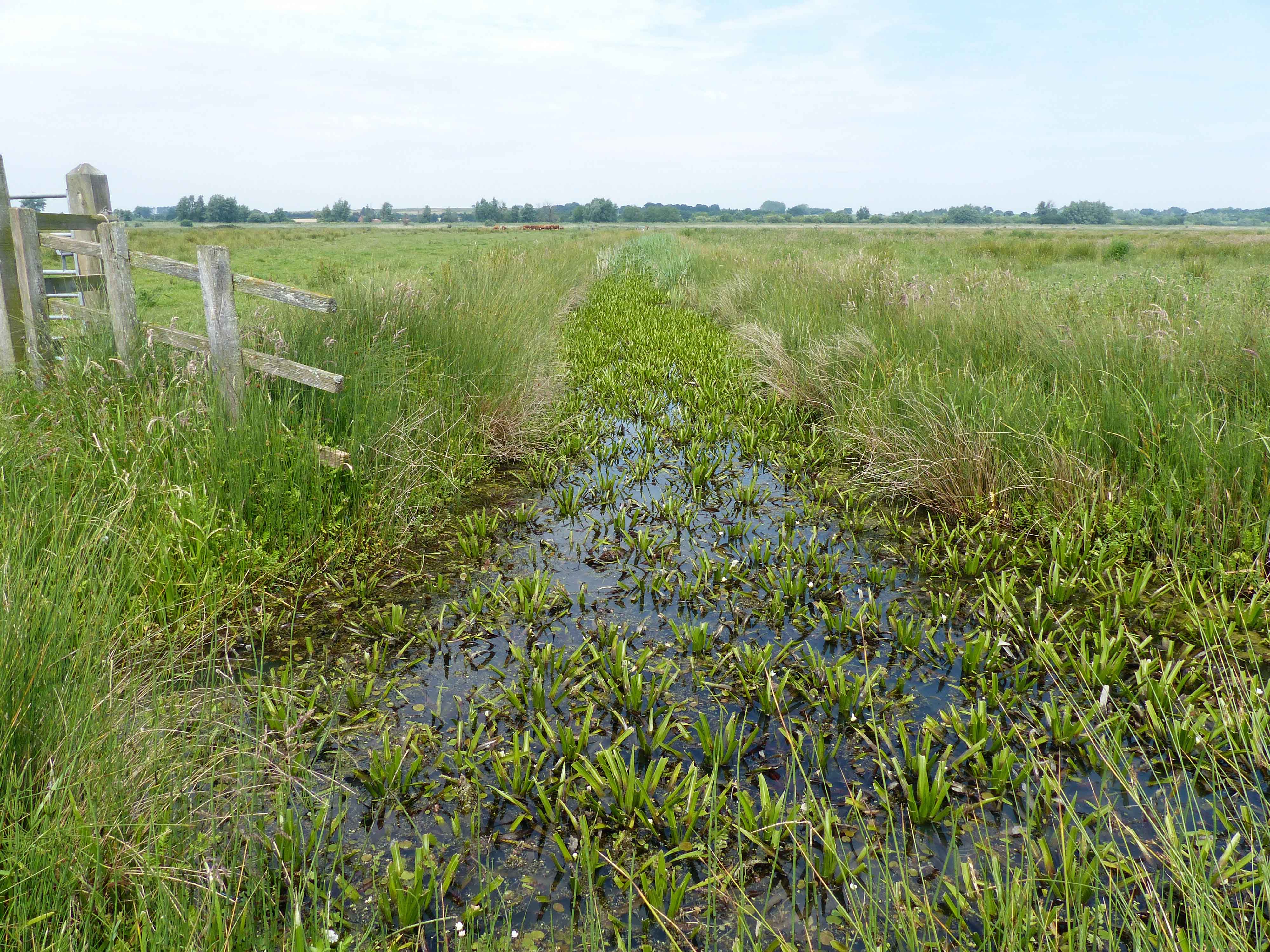
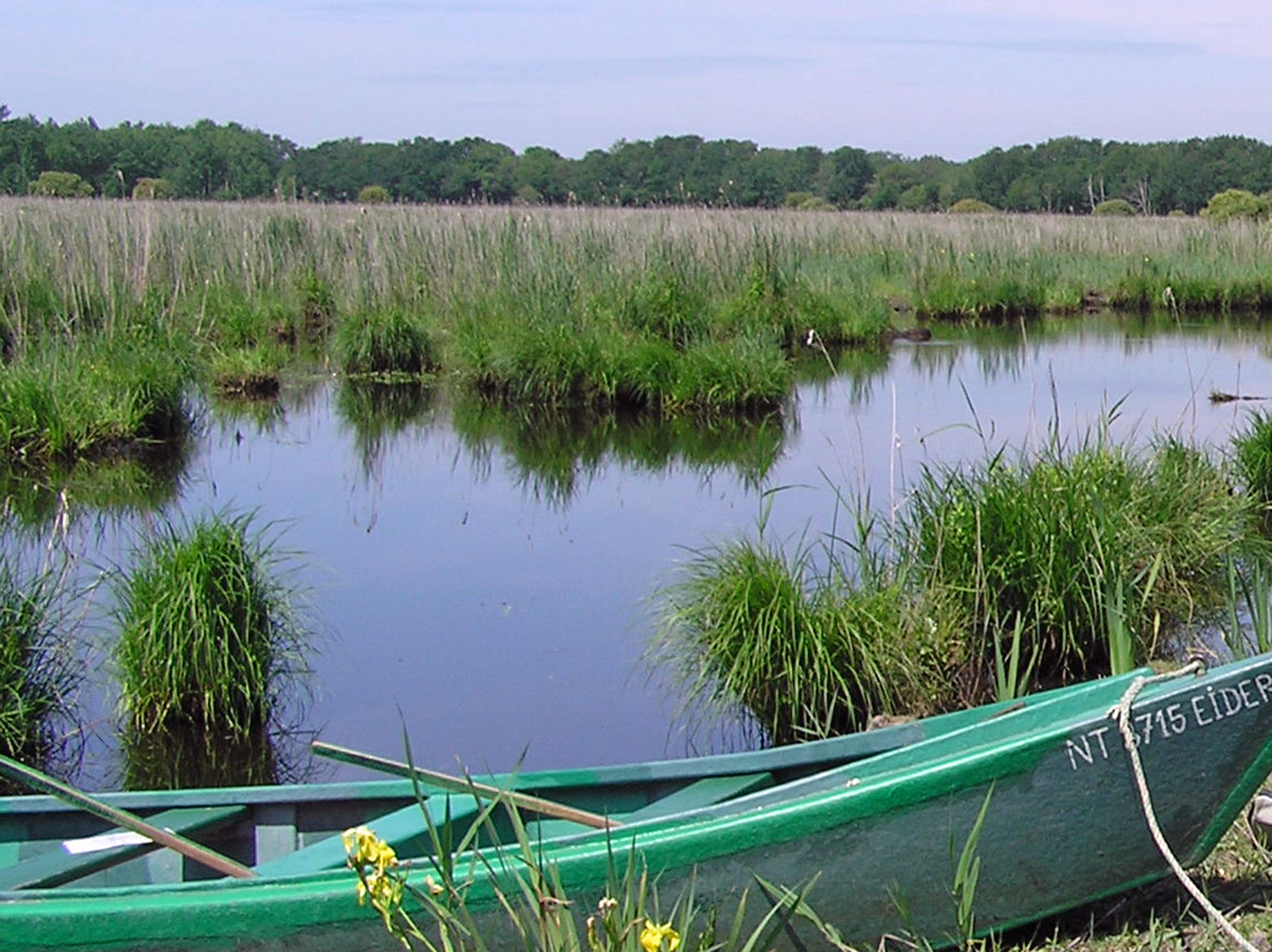
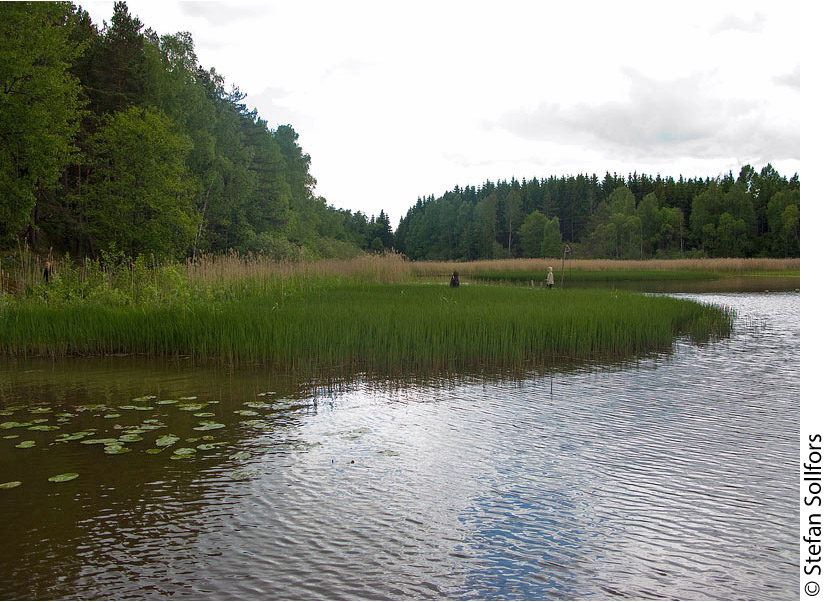
Throughout its range in central and western Europe, D. plantarius is a species of lowland wetlands. In Britain, it is found around the margins of grazing marsh ditches, canals and fen turf ponds where the water supply is generally base-rich but nutrient poor. It is typically associated with a rich invertebrate assemblage and with emergent and marginal vegetation with a high level of structural complexity. Vegetation dominated by stiff-leaved plant species that provide a rigid framework on which nursery webs can be anchored are particularly favored. These include Cladium mariscus in fen sites, and the floating rosettes of Stratiotes aloides as well as marginal Carex and Juncus species in grazing marsh ditches. Stands of Phragmites australis are generally avoided because they are densely shading and offer a less suitable structure for supporting nursery webs. In continental Europe D. plantarius is also found around the margins of monastic fish ponds and in extensive wetlands such as river deltas and areas of ancient fen peat diggings. In Scandinavia it is associated mainly with the margins of natural lakes. In contrast to Britain, it has been found in tall stands of P. australis in northern Italy, presumably because of the much higher insolation.
The present highly fragmented distribution of D. plantarius, and the well-know and massive extent of anthropogenic wetland loss over much of its range, suggest strongly that this species was formerly very much more widely distributed. The increasing challenges of retaining water quantity and quality in remaining wetlands is also likely to be a major factor in restricting this species' distribution: in Britain, a population decline at Redgrave and Lopham Fen National Nature reserve in East Anglia was associated with loss of a reliable year-round water supply. This was caused by abstraction for public water supply and compounded by summer droughts (see Conservation). Anecdotal evidence from the Netherlands suggests that populations decline, and may be lost, where its habitat becomes enriched by agricultural run-off.
On a prehistoric time-scale it is likely that D. plantarius was an extremely widespread species across Europe, exploiting extensive wetlands and interconnecting outwash plains to recolonise from southern glacial refugia. This is supported by data from mitochondrial DNA suggesting that the species retains relatively high levels of ancestral genetic diversity across its geographical range, despite evidence of restricted gene flow and demographic bottlenecks during its more recent evolutionary history (Vugdelić 2006).
The habitat of D. plantarius contrasts with that of the congeneric and very similar D. fimbratus, which, in Britain, is restricted to lowland wet heaths and upland acid mires (see Identification). Dolomedes fimbriatus appears to be rather less dependent on proximity to standing water, often constructing its nursery webs away from open water surfaces in shrubby species such as Myrica gale and Calluna vulgaris. Conditions suitable for both Dolomedes species may exist in close proximity in some sites. Populations of both species have been recorded sympatrically from sites in France.
Hunting and prey
Dolomedes plantarius is an ambush predator. It neither builds capture webs nor actively pursues its prey until it is within easy reach. In captivity the spiders produce diffuse webs but these appear to be simply the accumulation of silk drag-lines left as they move around in a confined space. The spiders appear to find it more difficult to capture prey in the presence of this web than in its absence.
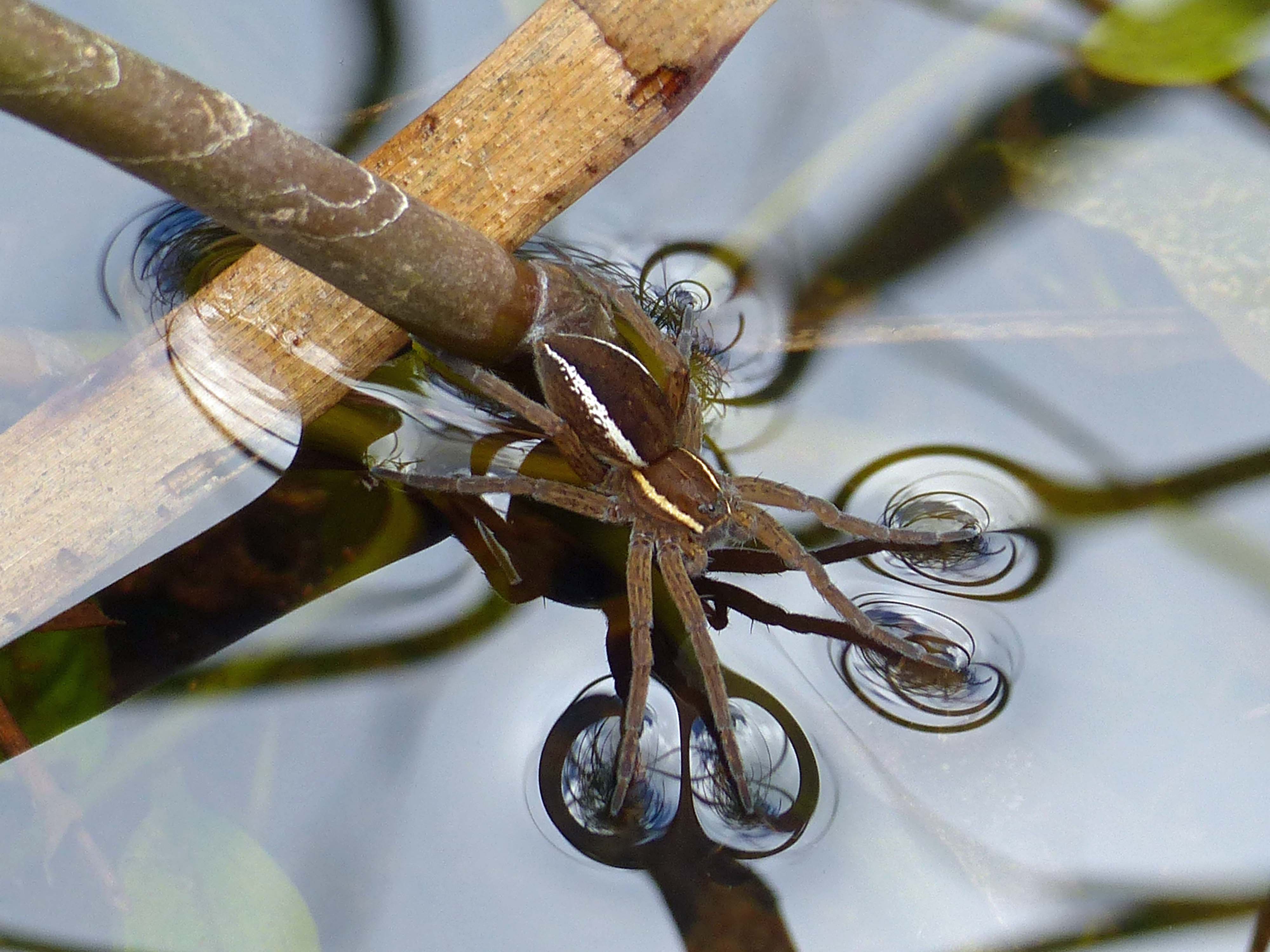
The adults and most immature stages of D. plantarius are usually found among marginal and emergent vegetation, basking or sitting in wait for their prey. In typical hunting posture they sit with their back legs on marginal or emergent riparian vegetation and their front legs resting on the water surface. Long, fine hairs (trichobothria) on the legs equip the spiders with an excellent vibratory sensory system (Blackmann & Barth 1984). This acts as an early warning system, allowing them to detect the direction, distance and of strength of movements in the air and on the water surface caused by both prey and potential predators. Water repellent (hydrophobic) hairs and body on the legs enable them to utilize the surface tension to rest on the water surface or to row or gallop across it to grab their prey. They can also break the surface tension and run down stems underwater to hunt for prey or hide from predators. Stefan Sollfors, filming in Sweden, has taken beautiful footage of D. plantarius in the wild, including shots of them hunting under water water; click here to watch on YouTube.
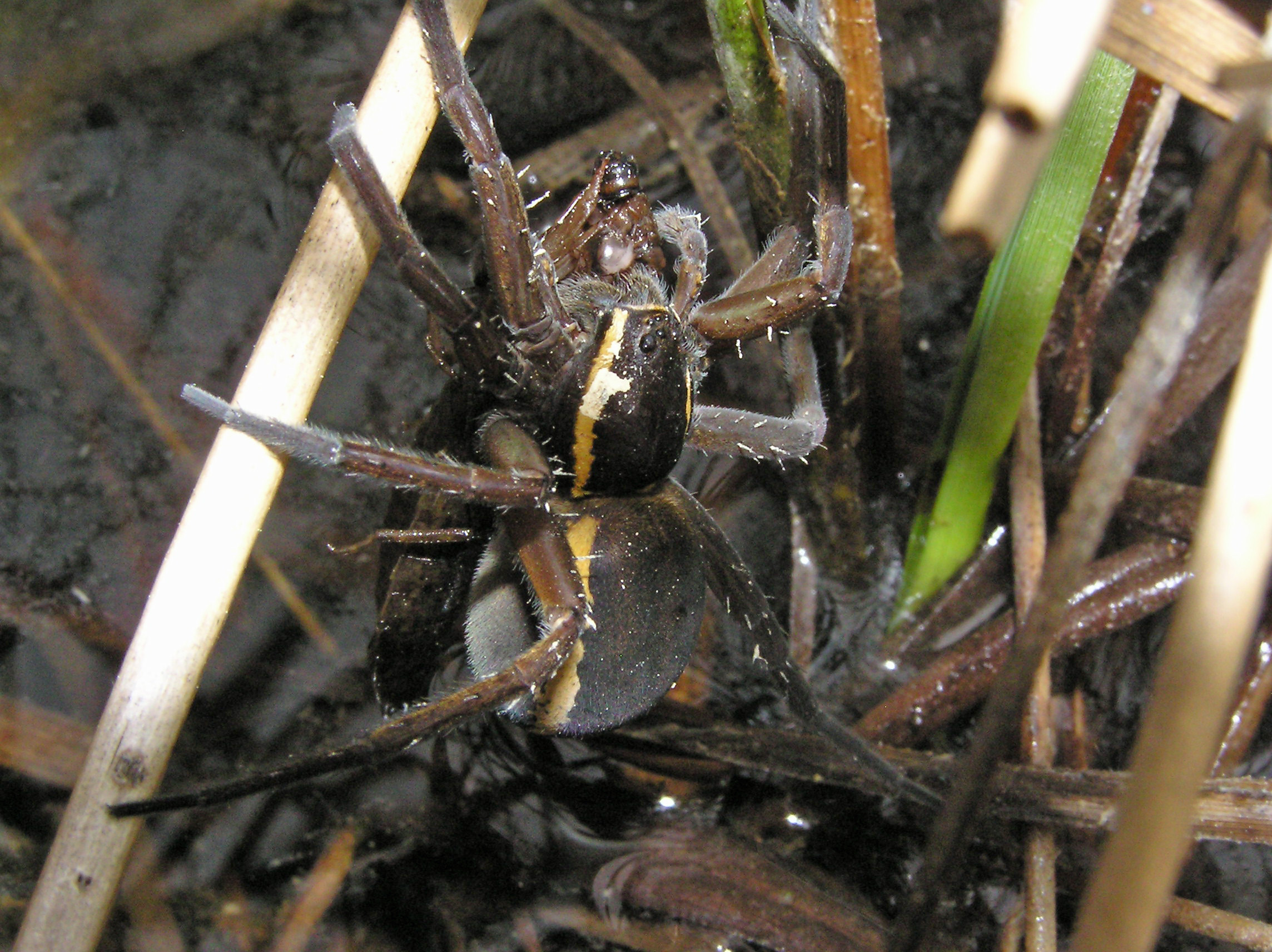
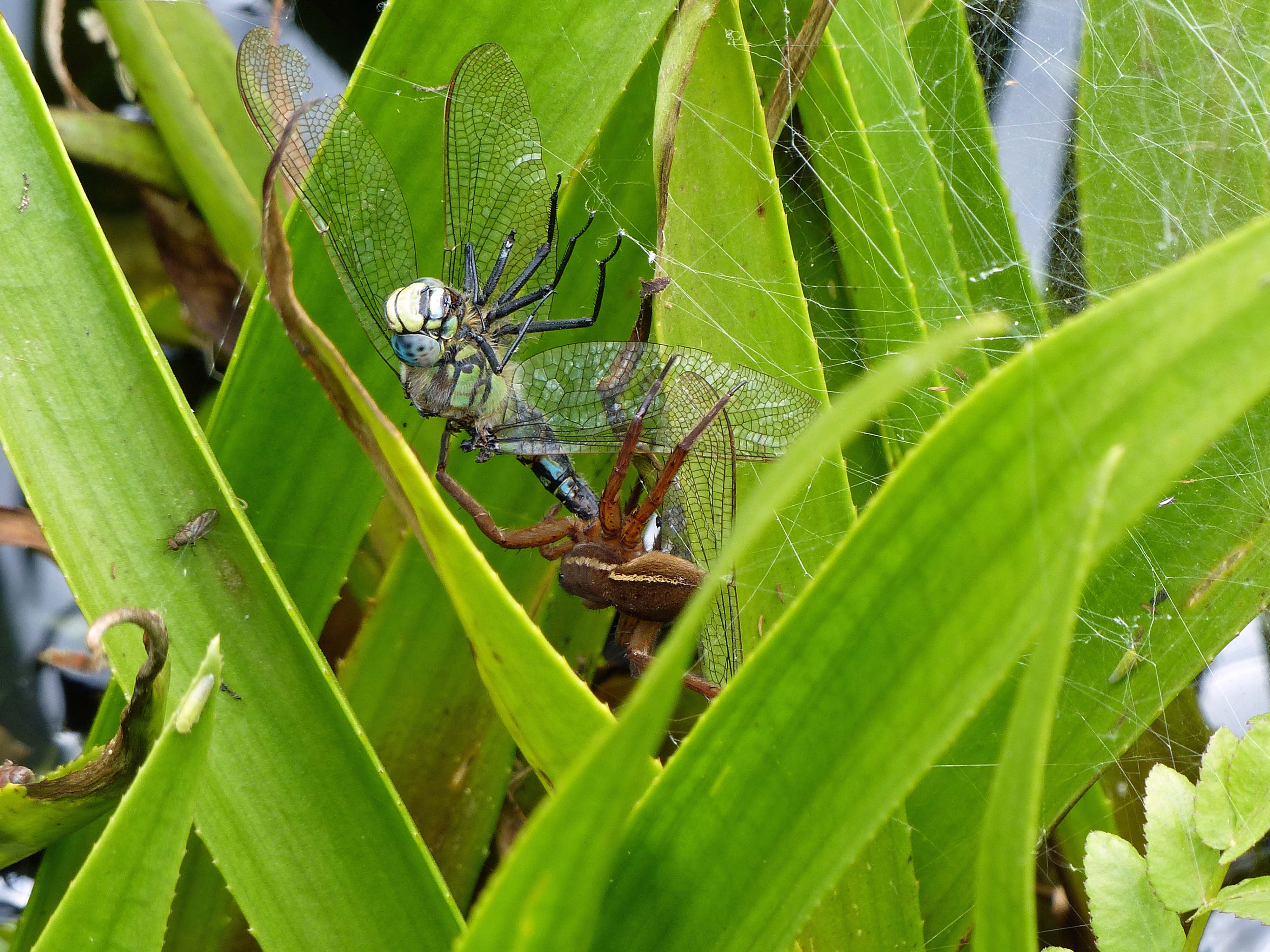
Dolomedes plantarius has a catholic diet, probably taking prey roughly in proportion to its abundance. Although it is often difficult to identify semi-digested prey, the primary prey species appear to be aquatic invertebrates, including smaller species of aquatic spiders, pond skaters, water beetles and both adult and larval dragonflies. Terrestrial invertebrates that fall into the water are also taken, as are small vertebrates, such are fish and tadpoles (Nyffeler & Pusey 2014), although these probably comprise only small proportion of the diet.
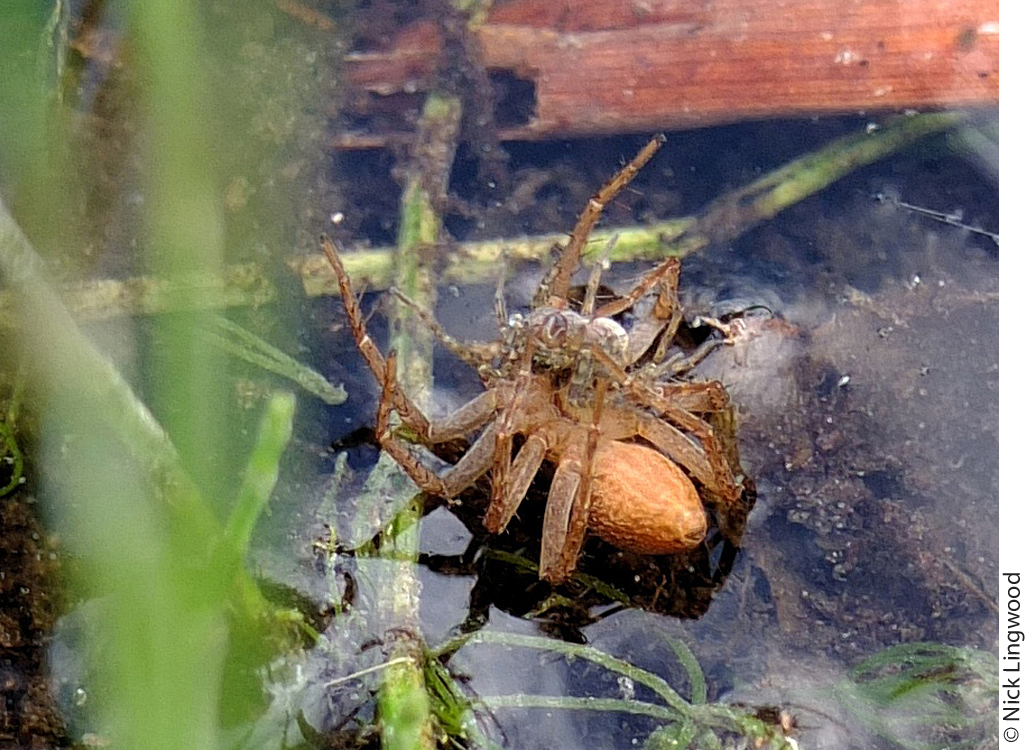
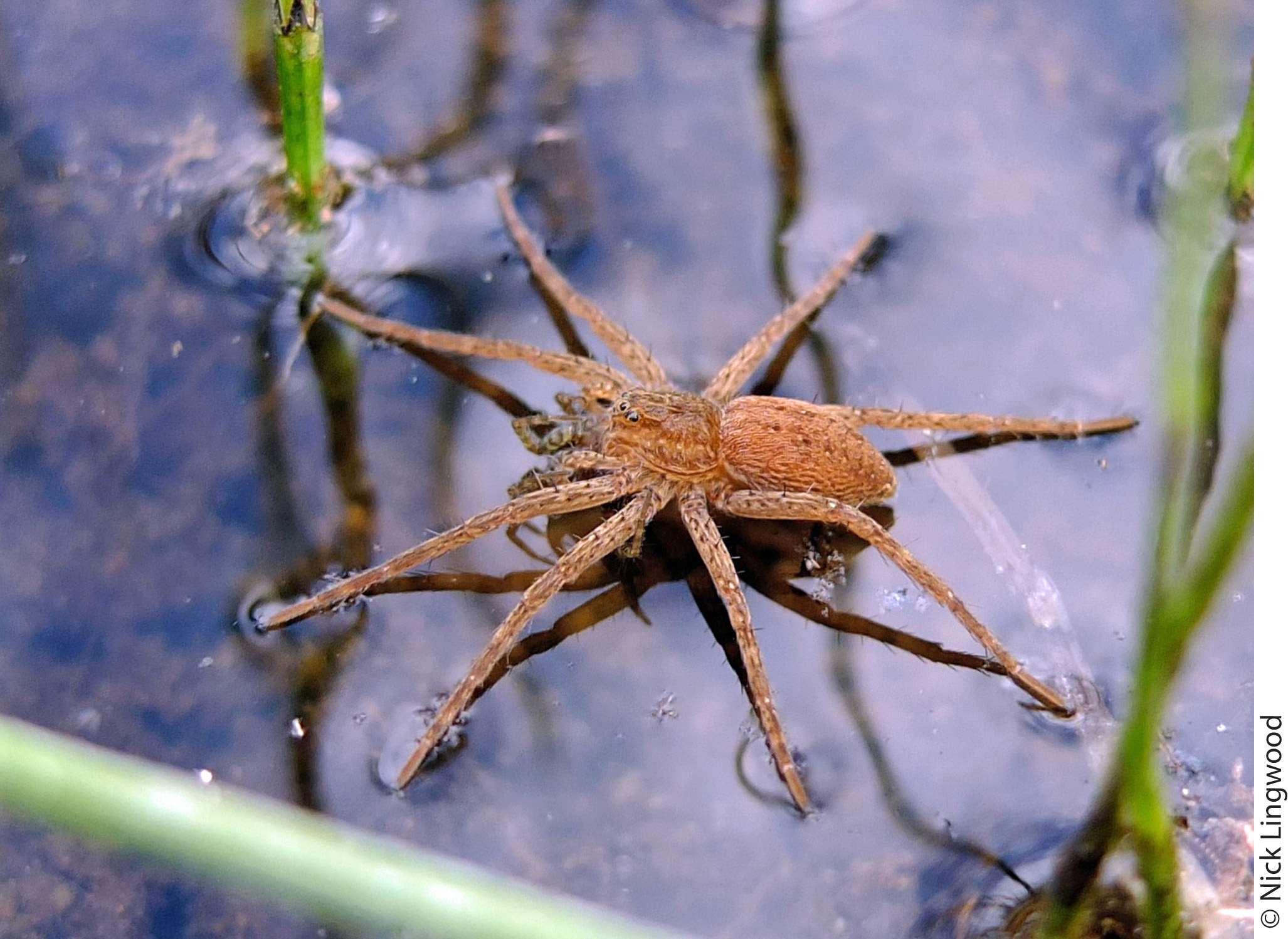
The front legs are used to capture small prey items. For larger prey the back legs may be used as well and the spider may turn over several times in the water in the struggle until the prey is immobilised by injection of venom from the fangs (see Stefan Sollfors video footage). Prey capture is so rapid that it is difficult to analyse the movements involved.
Predators
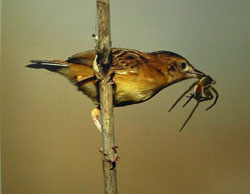
Cisticola juncidis with Dolomedes prey - Italy (photographed from an information panel in Abruzzo National park)
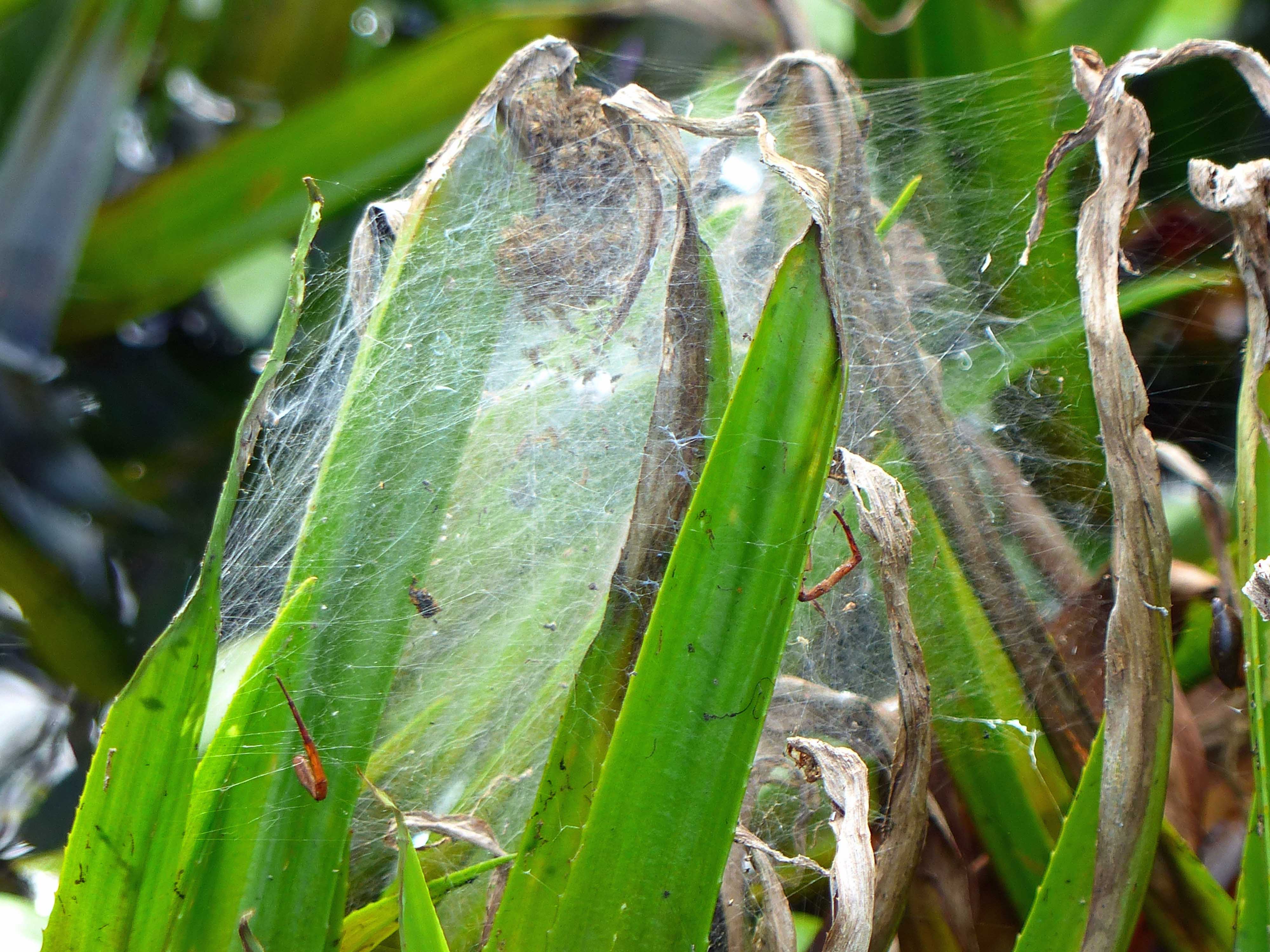
Little information is available on predators of D. plantarius. When small, the spiderlings are likely to fall prey, in large numbers, to a wide range of species. In the nursery they are vulnerable to avian insectivores, particularly when water levels are low and birds concentrate around the water margins to drink. However, both the strength of the nursery silk and their efficient escape mechanism (see below) makes it unlikely that a high proportion of a brood would be consumed in this way. Direct records of predation of large and adult D. plantarius in the UK are confined to two observations of them being eaten by frogs Rana temporaria. Observations of severed adult legs, with the body completely missing, may be attributable to predation by both birds and wasps. Two observations of predators taking large specimens of D. fimbriatus are also likely to be relevant to D. plantarius. One is of a hornet Vespa crabo capturing and taking a specimen in the New Forest, England, and the other is of a Fan-tailed Warbler Cisticola juncidis photographed with a Dolomedes in its beak in Italy. In the USA Carico (1973) reports a collection in Florida containing 32 adult Dolomedes trition taken from the gut of an immature Little Blue Heron (Egretta caerulea).
Dolomedes plantarius use their ability to hide underwater to escape predators as well as a hunting tactic. As an escape response, this is often accompanied by excretion - a white cloud of guanine in the water obscuring their presence. Adult females carrying egg sacs are particularly vulnerable to predation by visual predators when they sit in emergent vegetation up to a metre above the water in the days before their spiderlings emerge and the nursery is constructed. If near-by vegetation is disturbed they often escape by dropping vertically into the water.
Cannibalism
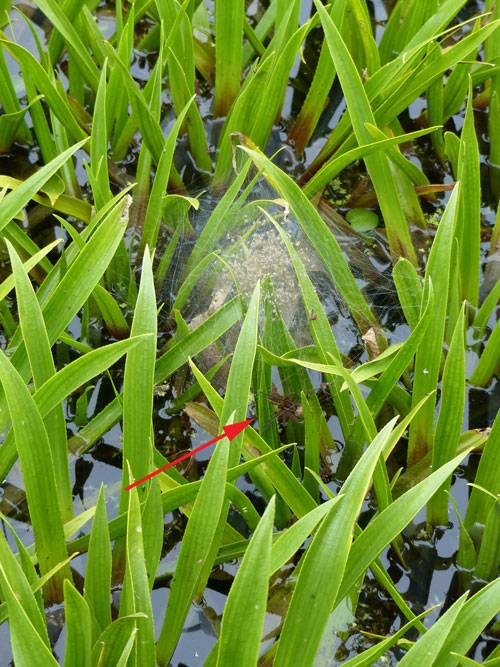
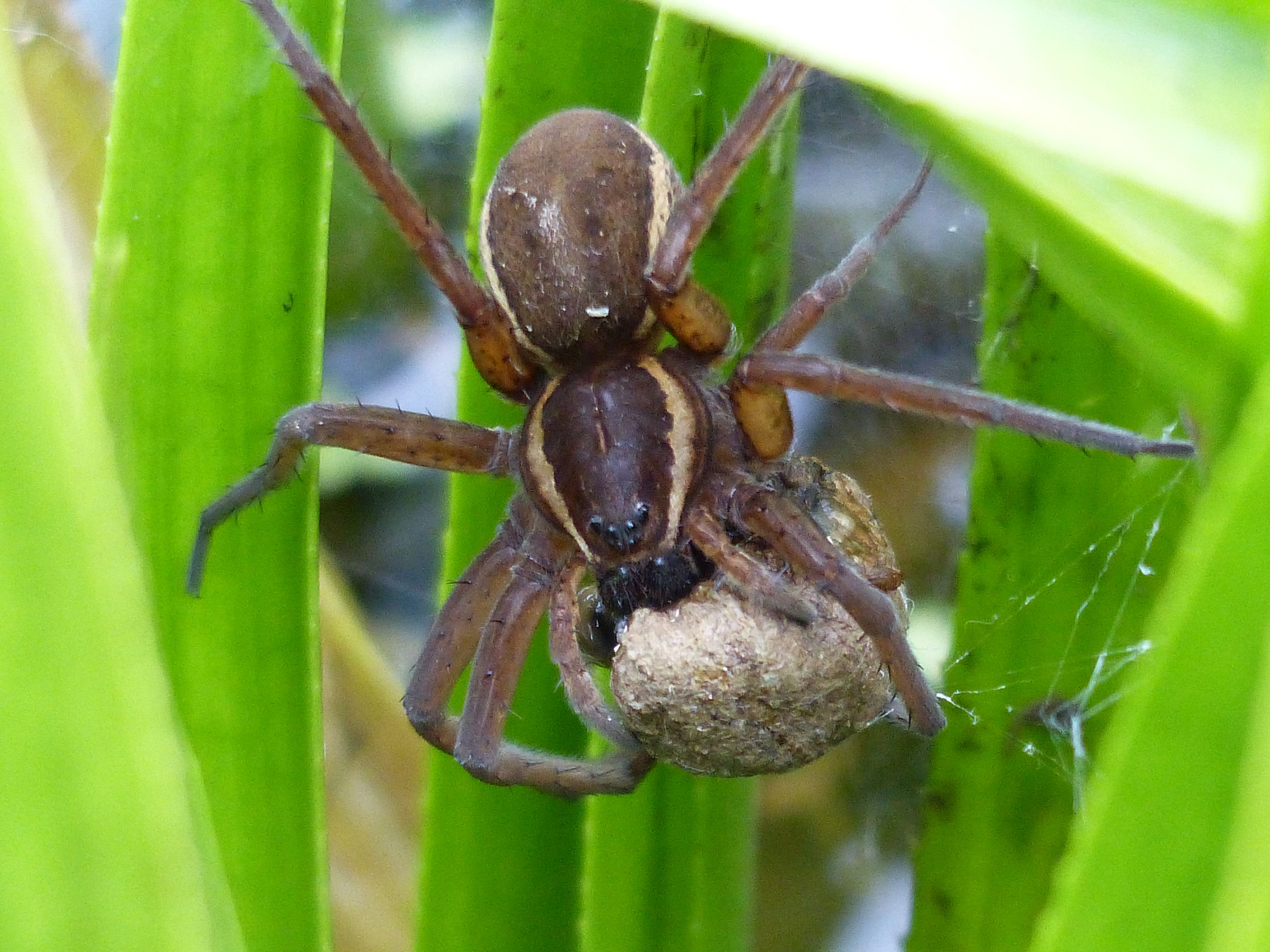
Cannibalism is thought to be relatively rare in the wild although it occurs among small juveniles in artificially crowded conditions in captivity once they are past the stage at which they would normally disperse from the nursery web. In the wild, D. plantarius often bask, or adopt and maintain hunting postures, within a few centimetres of one another. Most observations of cannibalism in the field are thought to have been triggered by one individual reacting to a rapid escape movement by another, often underwater, in response to human presence. Adult females have been recorded eating other adult females several times, usually where there are very high densities of nursery webs. Cannibalism of males by females during courtship is also very rare. It has never been observed in the field and only twice in the laboratory out of many pairings in a small experimental arena.
Locomotion
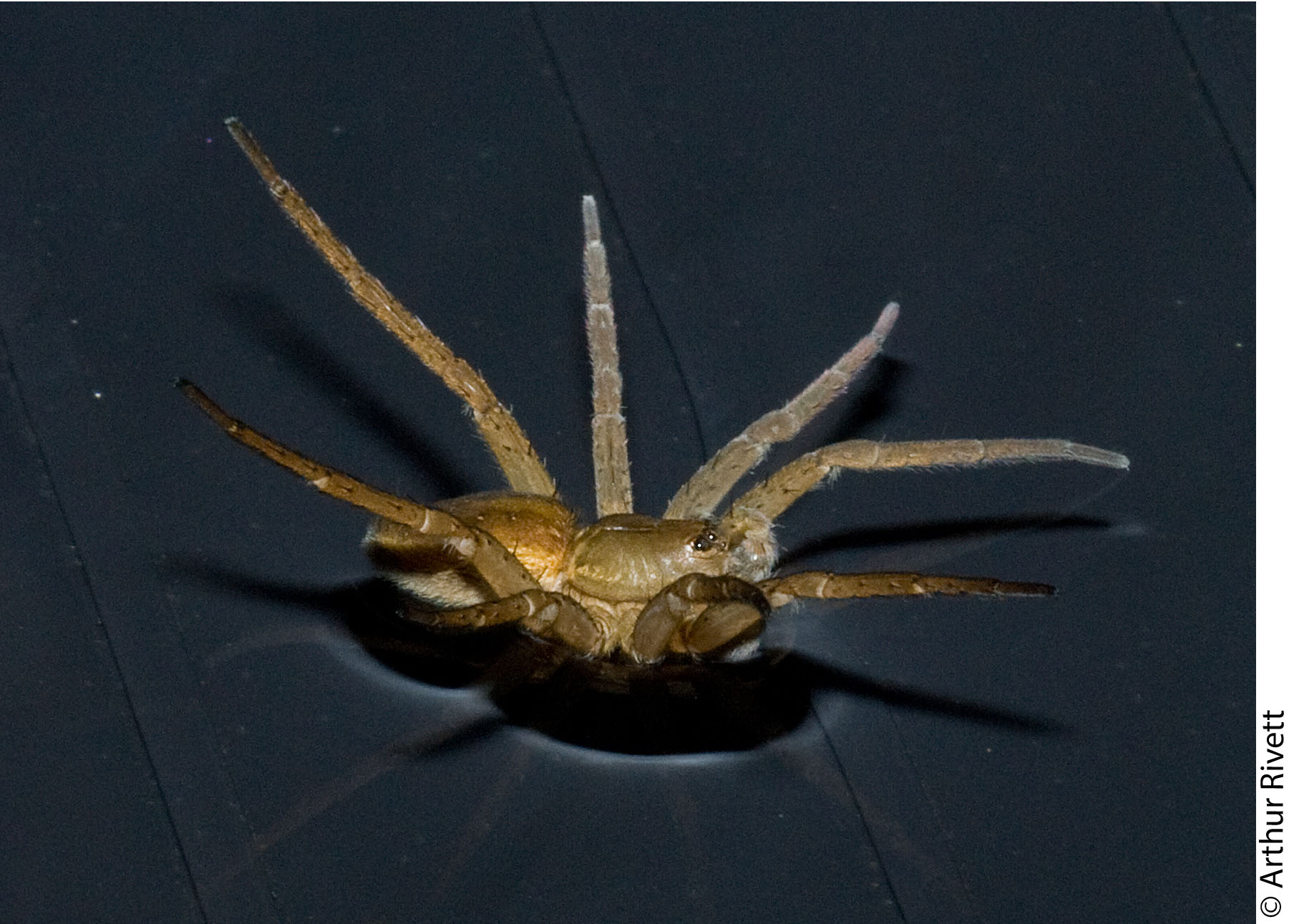
Dolomedes plantarius is a true master of the meniscus, superbly adapted to its semi-aquatic lifestyle. As well as rafting on the water surface, dimpling but not breaking the meniscus with its feet, it has two primary means of surface locomotion. It can travel slowly by rowing with its second and third pairs of legs and, in pursuit of prey, it can accelerate five-fold, using a high-stepping gallop to reach velocities of up to 0.75ms-1 (Gorb & Barth 1994, Suter & Wildman, 1999). To apply the brakes, the spider uses its tarsal claw to catch its ever-present silk dragline. In addition, in a gentle breeze, it can sail across the water surface by raising either its body, or between one and all eight legs. This is an energetically extremely efficient mode of transport, although it offers no choice of direction (Suter 1999a & b).
Dolomedes can jump vertically from the water surface, clearing several centimetres. Such jumps are effective in evading attacks by frogs (Suter 2003) although they may be inadequate to avoid attacks from below by some fish species (Suter & Gruenwald 2000). This behaviour has been observed in both D. plantarius and other Dolomedes species. Aerial dispersal of tiny spiderlings by 'ballooning' on silk lines is discussed under life-history.
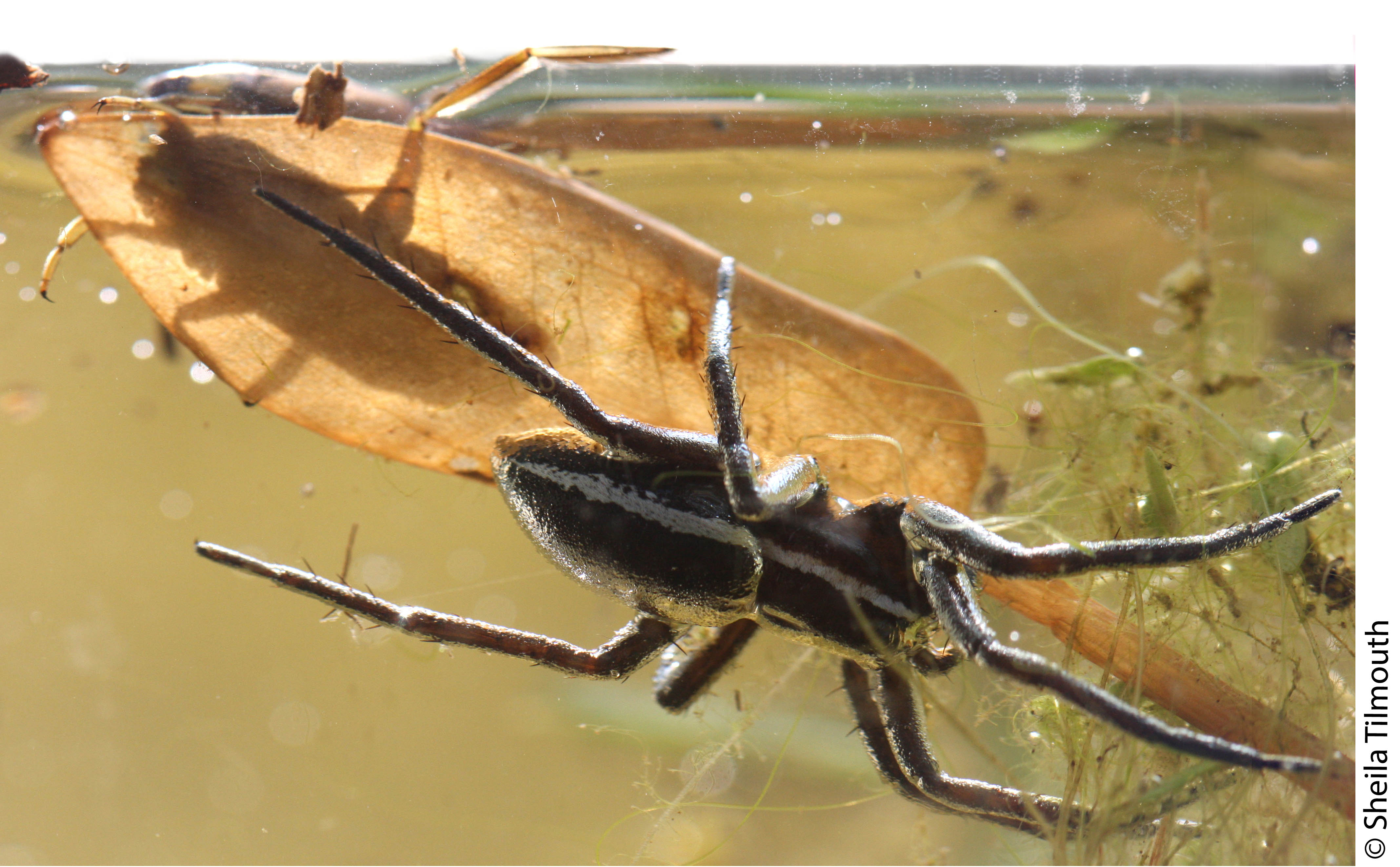
Unlike many other meniscus specialists, these spiders are also at home both on land, where they revert to a gait typical of terrestrial spiders, and underwater. Below the surface they appear as silver as a swimming water shrew, a dense, velvety covering of hydrophobic hair trapping a layer of air, and enabling them to remain submerged for protracted periods. Swimming between underwater stems is relatively restricted and clearly requires effort to overcome the buoyancy provided by the trapped air layer.

To enter the water, effort is required to break the meniscus which warps downwards around them, as if they are disappearing into a hole. Underwater they move along submerged stems to avoid bobbing back up to the surface; free-swimming is restricted by their buoyancy.
References
Bleckmann, H. & Barth, F. G. 1984. Sensory ecology of a semi-aquatic spider (Dolomedes triton): II.The release of predatory behavior by water surface waves. Behavioural Ecology and Sociobiology 14: 303-312.
Carico, J.E. 1973. The Nearctic Species of the Genus Dolomedes (Araneae: Pisauridae). Bulletin of the Museum of Comparative Zoology 144: 435-488.
Deshefy, G.S. 1991.‘Sailing’ behaviour in the fishing spider, Dolomedes Triton (Walckenaer). Animal behaviour 29: 965-966.
Gorb S.N. & Barth F.G. 1994. Locomotor behavior during prey-capture of a fishing spider, Dolomedes plantarius (Araneae:Araneidae): galloping and stopping. Journal of Arachnology 22: 89-93.
Nyffeler, M. & Pusey, B. J. 2014. Fish Predation by Semi-Aquatic Spiders: A Global Pattern. PLoS ONE 9(6): e99459. https://doi.org/10.1371/journal.pone.0099459.
Suter, R. B. 1999a. Walking on water. American Scientist: 87, 154-159.
Suter, R.B. 1999b. Cheap transport for fishing spiders (Araneae, Pisauridae): the physics of sailing on the water surface, Journal of Arachnology 27: 489-496.
Suter R. B. 2003. Trichobothrial mediation of an aquatic escape response: Directional jumps by the fishing spider, Dolomedes triton, foil frog attacks. Journal of Insect Science 3: 19.
Suter, R.B. & Gruenwald, J. 2000. Predator avoidance on the water surface? Kinematics and efficacy of vertical jumping by Dolomedes (Araneae, Pisauridae).Journal of Arachnology 28: 201-210.
Suter, R.B & Wildman, H. 1999. Locomotion on the water surface: hydrodynamic constraints on rowing velocity require a gait change.Journal of Experimental Biology 202: 2771-2785.
Vugdelić, M. 2006.Genetic relations within and amongst Dolomedes aquatic spiders. PhD Thesis, University of East Anglia.
